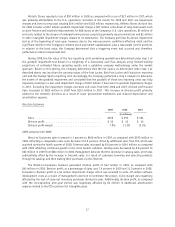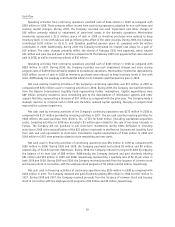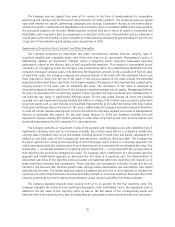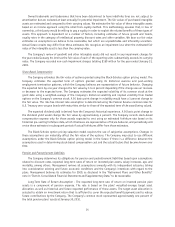Foot Locker 2009 Annual Report Download - page 40
Download and view the complete annual report
Please find page 40 of the 2009 Foot Locker annual report below. You can navigate through the pages in the report by either clicking on the pages listed below, or by using the keyword search tool below to find specific information within the annual report.
The Company does not have any off-balance sheet financing, other than operating leases entered into in the
normal course of business as disclosed above, or unconsolidated special purpose entities. The Company does not
participate in transactions that generate relationships with unconsolidated entities or financial partnerships,
including variable interest entities. The Company’s policy prohibits the use of derivatives for which there is no
underlying exposure.
In connection with the sale of various businesses and assets, the Company may be obligated for certain lease
commitments transferred to third parties and pursuant to certain normal representations, warranties, or
indemnifications entered into with the purchasers of such businesses or assets. Although the maximum potential
amounts for such obligations cannot be readily determined, management believes that the resolution of such
contingencies will not significantly affect the Company’s consolidated financial position, liquidity, or results of
operations. The Company is also operating certain stores for which lease agreements are in the process of being
negotiated with landlords. Although there is no contractual commitment to make these payments, it is likely that
leases will be executed.
Critical Accounting Policies
Management’s responsibility for integrity and objectivity in the preparation and presentation of the
Company’s financial statements requires diligent application of appropriate accounting policies. Generally, the
Company’s accounting policies and methods are those specifically required by U.S. generally accepted accounting
principles. Included in the ‘‘Summary of Significant Accounting Policies’’ note in ‘‘Item 8. Consolidated Financial
Statements and Supplementary Data’’ is a summary of the Company’s most significant accounting policies. In
some cases, management is required to calculate amounts based on estimates for matters that are inherently
uncertain. The Company believes the following to be the most critical of those accounting policies that
necessitate subjective judgments.
Merchandise Inventories
Merchandise inventories for the Company’s Athletic Stores are valued at the lower of cost or market using
the retail inventory method (‘‘RIM’’). The RIM is commonly used by retail companies to value inventories at cost
and calculate gross margins due to its practicality. Under the retail method, cost is determined by applying a
cost-to-retail percentage across groupings of similar items, known as departments. The cost-to-retail percentage
is applied to ending inventory at its current owned retail valuation to determine the cost of ending inventory on
a department basis. The RIM is a system of averages that requires management’s estimates and assumptions
regarding markups, markdowns and shrink, among others, and as such, could result in distortions of inventory
amounts.
Significant judgment is required for these estimates and assumptions, as well as to differentiate between
promotional and other markdowns that may be required to correctly reflect merchandise inventories at the lower
of cost or market. The Company provides reserves based on current selling prices when the inventory has not been
marked down to market. The failure to take permanent markdowns on a timely basis may result in an
overstatement of cost under the retail inventory method. The decision to take permanent markdowns includes
many factors, including the current environment, inventory levels and the age of the item. Management believes
this method and its related assumptions, which have been consistently applied, to be reasonable.
Vendor Reimbursements
In the normal course of business, the Company receives allowances from its vendors for markdowns taken.
Vendor allowances are recognized as a reduction in cost of sales in the period in which the markdowns are taken.
Vendor allowances contributed 30 basis points to the 2009 gross margin rate. The Company also has
volume-related agreements with certain vendors, under which it receives rebates based on fixed percentages of
cost purchases. These volume-related rebates are recorded in cost of sales when the product is sold and were not
significant to the 2009 gross margin rate.
22
























